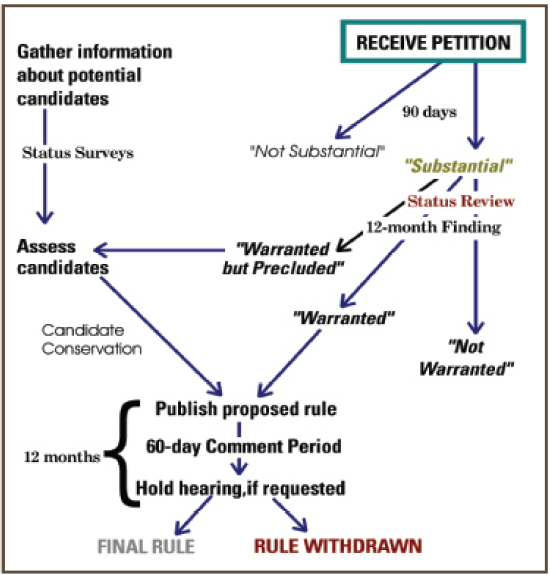Listen to the audio article of this blog post
This is the third installment of a three-part series detailing the listing process under the Endangered Species Act for the monarch butterfly.
Welcome to the final installment of Farmers for Monarchs’ series on the Endangered Species Act (ESA) listing process for the monarch butterfly. In our previous posts, we explored the intricate review process conducted by the U.S. Fish and Wildlife Service (USFWS) and then delved into the differences between a species being classified as threatened or endangered, along with an overview of critical habitat and the 4(d) rule. Now attention turns to the next critical phase: what happens if the USFWS proposes a rule to list the monarch butterfly as threatened or endangered? Understanding this rule-making process is essential for stakeholders, including farmers and landowners, who can play a pivotal role in shaping conservation efforts and regulatory policies. We again reference the chart below, which gives a visual overview of the entire process.

What is the Process Following a Proposed Rule?
Recall that in December 2020, the USFWS announced that listing the monarch butterfly was warranted but precluded by higher priority listing actions. In December 2024, the USFWS is expected to publish a 12-month finding on the current status of the monarch butterfly. If the monarch still warrants listing this finding would include a rule proposing to the list the species as either endangered or threatened. If USFWS determines a listing for the monarch is still warranted, it means that the species meets the criteria for being listed as either threatened or endangered under the Endangered Species Act. Several actions typically follow a proposed rule:
- Public Comment Period: A public comment period follows the publication of the proposed rule, during which public comments are collected on both the proposed listing and any – if applicable- additional provisions, like a proposed 4(d) rule and/or proposed critical habitat. This comment period typically lasts for 60 days. If the monarch is listed as a threatened species, farmers and other landowners will play a pivotal role during the comment period in shaping a potential 4(d) rule, giving flexible regulatory actions. This flexibility can incentivize proactive conservation actions while balancing economic and social considerations.
- Final Listing Decision: After considering public comments and additional scientific information, USFWS has a year to make a final determination on whether to list the species as endangered, threatened, or not list it at all. Alongside the final listing decision, the agency may also finalize the 4(d) rule (if the species is listed as threatened) and designate critical habitat one year after the proposed rule.
- Publication of Final Rule: The final rule detailing the listing decision, critical habitat, and, if applicable, the finalized 4(d) rule is published in the Federal Register a year after a proposed rule. A final listing rule generally becomes effective 30-60 days after publication in the Federal Register.
- Implementation of Protections: Once listed, the species is afforded protections under the ESA, which may include prohibitions on harming, harassing, killing, or otherwise taking the species. The 4(d) rule may provide exceptions or special regulations for certain activities related to the conservation of the species.
Your Voice Matters
Agriculture stakeholders will have numerous opportunities to engage and contribute to the regulatory process that may be initiated later this year. If a listing decision is determined to be warranted for the monarch butterfly, we strongly encourage farmers to participate in the review process. Your input during the public comment period will be crucial in shaping a potential 4(d) rule, allowing for flexible regulatory actions that balance conservation needs with economic considerations. This collaborative approach can facilitate proactive conservation practices that benefit the monarch butterfly while continuing to support agriculture operations.
As we await the announcement of whether monarchs warrant listing and a potential proposed rule, continued collaboration and active engagement will be key to ensuring a balanced approach that supports both species conservation and sustainable land use. Farmers for Monarchs will continue to convene agriculture stakeholders and inform our constituents with updates about this process and opportunities to get involved in conservation efforts. Regardless of any potential listing decision, we encourage farmers to continue participation in voluntary conservation efforts for monarchs and pollinators. Doing so can make a meaningful difference in the fight to protect the monarch butterfly and its habitat for future generations.
